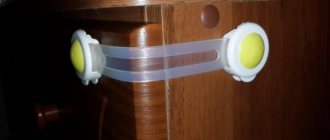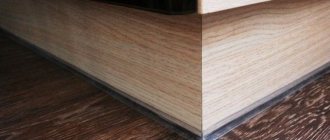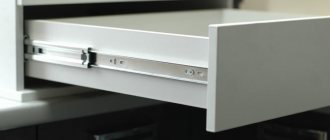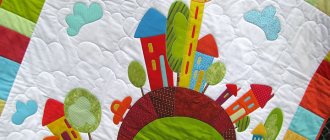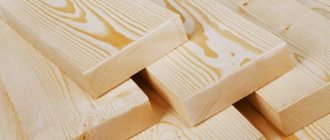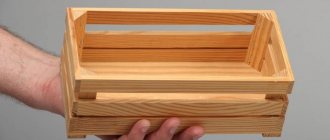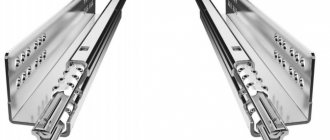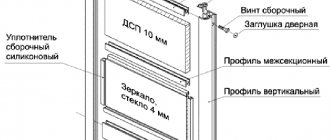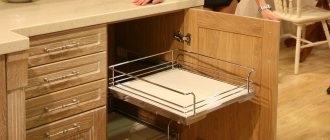In the modern world, it is possible to protect a child without resorting to damaging the furniture by cutting various locks and latches into it. Today there are a lot of different devices that are attached to furniture and do not allow a child to open drawers and doors. They will be especially appreciated by parents who want to organize a children's corner in their room.
Based on what kind of furniture is in the apartment and how the child tries to open it, the choice of protecting the furniture from the baby depends. But it is important to remember that protection on sliding wardrobes will not work on hinged wardrobes, and vice versa.
Here are several types of protection for furniture:
- You can install mortise locks or overhead locks. They are reliable, but their disadvantage is that installation requires drilling several holes in the chest of drawers or cabinets. Not everyone wants to ruin their furniture.
- There are also modern locks for doors and drawers. An adult can easily open them, but for a small child this is an almost impossible task. There are a large number of varieties of such locks.
- Another gentle option: installing new handles on furniture - with built-in locks. New holes on the facades will not be needed.
- And, of course, you shouldn’t forget about the possibility of protection using old folk remedies - a string passed through cabinet handles, or tape stuck to drawers. However, it should be remembered that such methods are far from the most reliable. But if it is not possible to use any of the above means of protection, then these will do.
Locking devices for drawers
First of all, let's turn our attention to the simplest options for locking drawer cabinets using special latches.
The price of the issue is one and a half to two hundred rubles and five minutes of time spent on installing the latches. Such locking devices are very common, they can be purchased in almost any store that sells children's goods. There are many names for such devices, for example canpol babies or drawer safety lock.
Such latches are made of plastic and glued to furniture using special reliable Velcro. Over time, they can be carefully torn off, without leaving any traces of glue. The latch consists of two elements, the main device and a plastic counterpart. The device is attached to the edge of the drawer with an overlap on its edge, and the counter part is glued to the body of the piece of furniture. When closing the drawer, you snap it tightly; to open it, you need to simultaneously press two small ears that are located on the body of the device.
A slightly more expensive and complicated, but even more effective way to lock a drawer is to use a handle with a built-in lock. The complexity of this method lies in the need to select a suitable handle so that it fits in place of the piece of furniture you are dismantling. Having bought a new handle, you simply screw it in place of the old one and lock the drawer.
How to lock a wardrobe from children?
Sliding wardrobes with mirrors are very attractive objects for small children. They are drawn to kiss the mirror, roll doors back and forth and pull out things standing on the lower shelves. Under these conditions, you will think about the need for child protection on the wardrobe. After all, pinched fingers and broken doors are the most innocent troubles that can arise as a result of a child’s acquaintance with such furniture.
You cannot install a classic lock on the door leaf of a sliding wardrobe, since it has a completely different opening principle. But this does not mean at all that there are no ways to reliably protect the closet from the attacks of a naughty child. There are two reliable ways to lock a wardrobe: the first method involves using a multi-purpose latch, and the second is using a special lock designed for such furniture.
The multi-purpose latch consists of three plastic parts connected by a special cable. One plastic part is firmly attached with glue to the door leaf of the wardrobe, and the other, called the retainer, hangs freely on a cable. If there is a need to lock the door, you just need to insert the lock into the counterpart attached to the cabinet body, and the opening is carried out with a special secret button.
A specialized fastener for sliding wardrobes has even greater advantages, since it does not need to be glued to the door leaf. It is attached with a latch directly to the handle. To lock the door, you just need to close it all the way, and the latch will come into contact with the cabinet body and block the door leaf. Opening is carried out by pressing a secret button “on the body” of the latch.
To summarize, we note that child protection on drawers and cabinets is not a manifestation of suspiciousness, but a severe necessity. After all, any closet or drawer can easily injure a child. Not to mention the dangerous things that such furniture can hide. Therefore, take care of your children in advance, especially since thanks to modern technology this requires minimal effort.
Interesting:
- Child locks for furniture
- Child lock on refrigerator
- Locks for metal and iron cabinets
- How to open a mailbox lock
- Window locks - all the subtleties of selection and installation
- Child locks on windows
Plugs for sockets
Sockets constantly attract the attention of children, so it is very important to protect the child from possible electric shock. Plugs for sockets will help avoid troubles.
Most often, the plug for the outlet is a plug, the size of the socket of the outlet. The pins inserted into the socket holes additionally hold the plug, making it almost impossible for a child to pull it out. The plugs are usually made of plastic with an additional sealed rubber or silicone gasket.
Additional security elements
To make a child's room and the entire apartment or house safer for a small child, you can use not only furniture mortise locks or the considered locks, but also a number of additional auxiliary components. For some, they can become the main decisions in the field of preserving the health of the baby.
- Shock absorbers. Plastic or rubber products that are attached to retractable furniture, doors, sharp corners and edges;
- Plugs. They serve to block access to screws, nails, and some decorative elements that are dangerous for children;
- Covers for edges and corners. Most often they are made on the basis of soft silicone;
- Protective tapes. They are used to cover the edges of various furniture. They are made on the basis of rubber or silicone with a sticky base for strong fixation.
I advise you to go to specialized stores and choose the best protection options.
Protection from sharp corners
Sharp edges of furniture pose no less danger to a child. The baby may hit the edge of the cabinet and cause dangerous injury to itself. But there are ways to protect yourself here too. A soft silicone or rubberized pad is glued around the perimeter of the piece of furniture that needs to be secured.
In addition to overlays, you can find silicone corners on sale that are attached to the sharp corners of furniture.
Manufacturing process
Stage 1
We drill a through hole 7 mm as in the photo. And in the box itself there is a hole of 3-4 mm and a depth of about 10 mm.
Stage 2
We prepare the screw: grind the thread and shorten it.
Stage 3
Insert the plastic plug into the screw head.
The homemade product can be modified: screw a 10x30mm metal plate onto the bottom drawers. Then, to open any bottom drawer, you will have to pull out the top one. A little inconvenient, but all the drawers are locked.
Outwardly, nothing is noticeable - the plug does not stand out against the general background. And if you don’t know the secret, you won’t guess it right away. Such a “lock” can be made not only on drawers, but also on doors!
Category: DIY furniture
0 Complaint Similar homemade products
We repair a furniture box ourselves. Woodland-style cribs. Homemade products for assembling furniture and baguettes.
Shelves made of wooden boxes
Chairs made from bottle crates
How to make a wardrobe out of drawers 3 comments×
Safety in the nursery and other rooms
A completely safe home for a child will only be possible if you think through everything in detail and pay attention to every corner of your home. Let's start with the nursery
This is where the child spends most of his time, often without adult supervision. First of all, you need to look at what is around the crib and move it to the side if there is an electrical outlet nearby, a table or shelf with medicines and baby care products, pots with indoor flowers, a closet with opening doors.
The loft bed or bunk bed must also be safe, that is, have appropriate barriers to prevent the child from falling. The Swedish wall is unthinkable without a soft mat.
When a child begins to crawl, some parents solve the issue of child safety in the apartment by purchasing a playpen. If restricting your baby’s freedom of movement is not your method, then take a careful look around. What can attract a child, what can he reach? Lock all cabinets with doors, remove all hanging objects from tables and shelves, this can be not only tablecloths, but also hanging wires of landline phones, table lamps, irons and other heavy objects.
Be sure to cover all sockets with plugs - this is the most basic safety aspect for children regarding electricity. In addition, there are special cases for sale for surge protectors and protective boxes for sockets.
All cabinets, shelves and shelves must be securely fastened so that a climbing baby cannot tip them over. And, of course, all the corners in the children's room should not be sharp and dangerous - for this there are silicone pads that are glued to the corners of tables, bedside tables, cabinets, chests of drawers and protect the child from injury.
Separately, we need to talk about interior doors and cabinet doors. To prevent a child from accidentally pinching their hand, it is better to install child protection on the doors, for example, a door shock absorber, which prevents the door from slamming suddenly. Lockers will not allow a child to open the cabinet doors, and special child safety barriers and flexible locks will protect against children from entering the depths of the cabinets. A little advice - choose a lock that has a complex opening system, for example, you need to press several buttons at the same time to unlock it.
And be sure to keep your front doors locked! By simply pressing the handle of the front door, the child will go to explore the staircase, and there, as you know, lurks the danger of falling from a height.
How can the bathroom be dangerous for a child?
The bathroom is the second most common place for children to be injured. This happens due to children's curiosity and parental inattention.
Household chemicals
To keep your child safe, put all household chemicals out of reach: soap, shampoos, hair sprays, shower gels, shaving products, fabric softeners and powders. They must be inaccessible to the child!
If there is no space in the bathroom for wall cabinets, purchase a sliding screen-screen for the bathtub. She will reliably hide all the dangerous chemistry behind her.
Wall mirrors, floor shelving, cabinets and shelves in the bathroom must be securely attached so that a child cannot tip them over.
Electrical appliances must not be left connected in the bathroom: hair dryer, electric razor, curling irons and straighteners, curling irons, etc.
When bathing, you should never leave your child alone, even for half a minute. The baby may choke or climb over the side of the bathtub and fall to the floor.
Another danger for older children is that they may turn on the water taps. Turning on hot water can cause your child to get scalded.
For safety, it is better to place a special anti-slip rubber mat on the bottom of the bathtub, which will save the child (and even the adult) from falling.
The tiled flooring should also be covered with a non-slip mat. Keep floors dry. Otherwise, the child may fall and hurt himself. It’s even worse if an adult falls with a child in his arms.
Toilet
Install a special lock on the toilet lid that will block access to water. This way you will protect your child from germs, bacteria and “unplanned bathing”. At the same time, phones, toys and house keys will also remain unharmed.
Danger of electric current for a child
To date, there are no children who are safe from electric shock.
If parents do not take precautions, then your child may also be in danger. If a child tries to insert a fork or other metal objects into the device, then you will not be able to avoid the danger.
This is why many parents prefer special sockets. They are created in such a way that it will be difficult for a child to notice them.
Also today there are a number of devices that have protective properties. Special sockets can prevent tragedy, but not always. You should never rely on technology, as sometimes it can work too late. In this case, you will not be able to save the child’s life. If we talk about sockets that have a protective device, then you should remember that their installation is appropriate in the bathroom.
In the Internet
Tell stories
Share stories with your child about how scammers beg for money, find out and use personal information, and manipulate children, the elderly, and advanced users. Let him know that anyone can fall into a trap, regardless of experience or age. The child should gradually form the impression of when a situation is normal and when it goes beyond what is permitted.
2
Teach reasonable caution
Discuss with your child how to communicate online. Tell them that scammers know how to ingratiate themselves and can build relationships with a victim for several months and then do harm. Therefore, it is best to communicate with those whom he already knows in real life: with children from school, from clubs, sections, with relatives
If an online acquaintance appeared from a game chat or in some other way, it is important to limit communication only to the topic of this game or the channel on which the communication began
Important. Psychologists believe that it is impossible to read a child’s personal correspondence, but you have the right to know who exactly your children are communicating with.
Ask to see the list of recipients in instant messengers and social networks, ask who is hiding behind the incomprehensible nicknames, why the child is interested in this person, what they are talking about. Keep a businesslike tone and explain what is important to you.
Instructions for locking cabinets and cabinets from children:
- If the furniture is equipped with locks, then it is necessary to close all doors with keys, and then put them out of the reach of children.
- Hinged cabinet doors can be closed by tying adjacent handles together with rope. To do this, the rope is passed between the handles in the shape of a figure eight and tied in a knot. This method is suitable for shelves that are used on rare occasions.
- For doors and drawers that have to be used frequently, special protective devices purchased in children's and hardware stores are suitable. A locking lock is an easy-to-use and inexpensive mechanism that is designed for different types of doors. Using these locks, you can easily lock sliding, folding and swing doors with close adjacent handles. They are produced in various versions. For example, to lock swing doors, use U- and C-shaped locks and locking rings for cabinet handles. After dismantling, they do not leave any marks on the surface of the furniture.
- It is convenient to glue soft locks to sliding and glass surfaces without handles. Thanks to the adhesive surface of the clamps, they are easy to dismantle, because they do not leave marks on the furniture. The disadvantage of soft locks is that a child can learn to open them on their own, but this can be overcome by gluing the locks higher. In addition, these universal locks are used on the surface of the refrigerator, microwave oven, toilet lid and even on windows.
- The latches will help prevent the drawer from falling out on your feet. They are attached from the inside with screws or Velcro on the side from the outside. The side latch can only be opened by pressing the buttons simultaneously while pulling the drawer towards you.
There are many manufacturers of home security devices. The most popular are the following:
- Mothercare (UK);
- World of Childhood (Russia);
- Canpol (Poland);
- Chicco, Poupy, Brevi (Italy);
- Safety First (Netherlands);
- Baby Dan (Denmark);
- Bebe Confort (France);
- IKEA (Sweden).
Products of Polish and Russian brands have an affordable price, which can be 5-7 times lower than that of brands from European manufacturers, while the quality of their products is also at the same high level.
Even if you consider all these protective devices to be a whim of inventors, you will still have to come up with something at the moment when the baby learns to crawl. After all, literally everything falls into his field of vision - from a boiling kettle on the stove to a mosquito net on the windows. So, various protections are not a whim, but a necessity for those conscious parents who do not want to remember the first couple of years of the baby’s life as time spent in traumatology.
The danger of basic household items cannot be underestimated - burns, falls, bruises and fractures are possible, because the child does not know how to properly handle the familiar objects around us.
Safety for children at home: door lock
Types and models of blockers
Locking locks are designed for hinged sashes and doors. Depending on the type of handles on the doors, they come in different shapes. These locks are very easy and quick to install on cabinet handles and securely hold the doors in the closed position. Door locks of this type look neat and will not damage your furniture. They do not tear or stretch when opened and closed multiple times, and are quite strong and durable.
For sliding doors and drawers in a chest of drawers or cabinets, soft Velcro locks are suitable. They are attached to the side and front surfaces of the furniture and connected with a special fastener, thereby keeping the drawer from sliding out. Depending on the model, the locking mechanisms may be different: special hidden buttons, hooks and ears. Locks of this type can also be used to lock the doors of kitchen appliances that are dangerous for children (refrigerator, microwave oven, oven). After all, the baby is unlikely to limit his travels to the living room and his children's room.
To protect the child from a heavy box falling on his feet, you can attach special latches that block the extension. Even if a young fidget somehow manages the lock blocking the drawer, the latch will work when pulled out and will not allow the drawer to be pulled out of the cabinet too far. Such devices are attached to the inside of the furniture and block the movement of the drawer to a certain amplitude. Fastening is carried out either using bolts or using holders glued to the inner surface of the box
More expensive models of locks and security devices are often equipped with a special built-in sensor that emits an audible signal when an attempt is made to open incorrectly (pulling the handle while the lock is closed or applying force to the mechanism itself). The intensity and type of sound signal can be adjusted through the settings. For vigilant parents, this is undoubtedly a significant advantage.
Defense Mechanisms
The simplest devices for locking cabinet doors and cabinets can be made with your own hands. Our mothers and grandmothers used such simple methods using improvised means. Two adjacent door handles can be tied with a strong thick thread, rope or elastic band.
The disadvantage of this method is that the baby may well, over time, master the method of getting rid of such a “lock” and, with his own hands, open up access to the hidden depths of the furniture shelves. In addition, this is inconvenient for adults themselves, because the rope or elastic band will have to be removed every time you need to take something from the closet, and then re-attached to the handle.
Drawers or wardrobe doors can be blocked by gluing a strip of wide adhesive tape or insulating tape to their sliding surface. The disadvantages of this method are the same as those described above. In addition, the tape will leave sticky marks that are difficult to remove on furniture surfaces. You can curtain a chest of drawers or a cabinet with a large blanket or tablecloth.
The child will most likely see only a solid piece of matter and move on to more interesting things. This method is only suitable for very small and unintelligent children. It can be used as a temporary measure until more secure locking devices can be installed as soon as possible.
Sometimes furniture doors or drawers are equipped with mortise locks. Basically, such locks were often found in old furniture. In this case, you just need to find the key and do not forget to close the lock on the furniture with it after each use. Keep keys to cabinets and shelves out of the reach of small children. And of course, it is very undesirable to forget the storage location or lose the treasured key. In this case, taking the necessary items from bedside tables and chests of drawers will no longer be possible for an adult. However, modern furniture manufacturers do not often embed locks into drawers and doors.
If possible, it is better to take care of such furniture in advance by choosing the appropriate model or having it made to special order. It is not entirely advisable to embed such locks into existing furniture. The difficulty is choosing the lock itself.
Personal protective equipment for babies
When a baby just starts to walk, falls happen all the time. To reduce the risk of injury, it is worth purchasing protective equipment for your baby that covers the “weakest” places: knees and head. (OK Baby helmet (about 3,000 rubles), Sevi Baby Comfort knee pads (about 500 rubles)).
For confidently running children, socks with silicone slip prevention on the soles are a must. Additionally, you can stick special anti-slip strips on the floor, this will cost about 150 rubles.
Some of the listed things seem superfluous only until the first precedent. Children’s imagination very often goes beyond the understanding of adults, so you need to think about the baby’s safety very seriously. In the end, in a safe space, the parents themselves will be much calmer about the baby.
PS Specialized stores sell special kits for the safety of children at home, which include sets of plugs for sockets, protection for drawers, doors, locks for the refrigerator, toilet, and corner covers.
On this topic:
- A complete list of things for a newborn baby
- 9 unusual baby gadgets you didn't know existed
- List of first aid kits for newborns
Interlock locks
As for the furniture itself, its design should not raise doubts about its stability; there should be no sharp corners. Shaky furniture should be strengthened or moved to another room where the baby has no access. The task of parents is to protect their child from possible bruises, and themselves from unwanted disorder.
All parents know how dangerous it is to play with the closet door. To prevent your child from accidentally pinching his fingers or using prohibited items for play, you can use special devices. These are so-called blocking locks.
They differ depending on the types of doors:
For door wardrobes and sliding wardrobes. Universal models are designed for two types of doors. The device looks like two button-shaped clips that are glued to the cabinet: there are models with an adhesive base or with suction cups. They are connected to each other with an elastic plastic tape.
For swing doors. This option differs in the need to use screws. Such products are suitable for wooden furniture. One part of the blocker is screwed from the inside to the door, the other to the top wall. Swing doors are also locked using U- and C-shaped locks and rings that fit onto the cabinet handles.
For glass. Some cabinets have fragile transparent doors, and they arouse special interest from children: after all, through glass everything seems even more tempting. Locks in the form of hook-locks are specially made for glass doors.
How to make your apartment safe for your baby
Danger: the child opens cabinets and drawers, from which he can get dangerous objects.
Exit: interlock locks. There are three types - for hinged doors, for drawers, and also for cabinets whose doors go down. And there are universal ones: two “button” holders with Velcro are attached to different parts of the furniture (say, two door leaves or a cabinet door and its base), with a plastic tape running between them.
Do it yourself: the easiest thing to do is with hinged doors - just tie them with an elastic band or seal them with masking tape (however, one piece will last no longer than 4-5 days). But it is better to block sliding and lowering doors with special devices.
Locking devices for drawers
The most popular method of protection is special latches, one part of which is attached to the furniture frame using special Velcro, and the second half is attached to the front of the drawer. Such protective devices can be purchased in specialized children's stores. They are inexpensive, and not much time is spent on their installation. When the need for such latches passes, they can be easily removed, and not a trace will remain of them on the furniture.
There are many varieties of such latches, but their essence is that each such lock has a main element, which is fixed and remains motionless, and a counter part, which acts as a lock.
It is possible to install handles on furniture or, for example, on windows with a special built-in lock. But this method is a little more complicated than described above, since you will need to find handles that would fit in place of the handles installed on the furniture. After you have bought such a handle, it is installed on the drawer, and it is simply locked.
What to do if the door is faulty?
For wardrobes where the doors slide parallel to the front plane, sticking is a common problem.
Then the doors either stop opening or get stuck in the open state and do not return to their place. What to do about this problem?
Main causes of malfunction:
- Dust and dirt have accumulated inside the guides, and the rollers can no longer easily slide along the standard path.
- The rollers are worn out and can no longer turn easily.
- The rollers were installed incorrectly and do not fit into the guides.
- Due to the uneven floor, the operation of the mechanism was disrupted.
- There is some play in the roller mechanism.
You can correct these shortcomings like this:
- Remove accumulated dirt with a vacuum cleaner. If the dirt is too dense, it must first be soaked with a damp cloth or sprayed with water from a household spray bottle. Accumulations of dense dirt can be removed with a narrow spatula, a ruler, or simply a sharpened stick.
- Replace worn or defective rollers with new ones.
- If the door was installed incorrectly, it must be corrected so that the rollers fit on the guides.
- If the floor is uneven, you can correct the curvature with spacers of the required thickness, placed under the base of the cabinet or under the guide.
- The mechanism can be corrected by tightening the fasteners.
Closing the closet from the child
Hinged cabinet doors are also better protected from children. Otherwise, leaving him alone for a minute, you risk returning to the room to find a pile of linen from the lower shelves and your little one happily frolicking with him. As a rule, U-shaped latches are installed on swing doors.
This is the simplest method of protection, since it does not require drilling holes in the furniture, or even gluing the protection to the surface of the furniture.
You can also use latches in the form of plastic hooks. They consist of two parts: the first part is attached to one cabinet door, and the other - the hook itself - is installed on the other door. When the doors are closed, the cabinet is locked with a hook.
The closet door can also be locked. A mirror on a wardrobe is a very attractive item for a baby. Usually, small children enthusiastically roll closet doors, look at their reflection in the mirror, and drag all the things from the lower shelves to the floor.
Of course, devices that are installed on hinged cabinets are not suitable for sliding wardrobes. But still, today there is protection for such furniture. The most popular type of security for sliding wardrobes is the butterfly latch. It is installed on one of the doors, next to the second door. When the “wings” are lowered, the cabinet door is in a movable state. By pressing a special button, the “butterfly wings” rise and prevent the cabinet door from rolling.
Operating principle
The mechanism of child locks is quite simple. It is based on two elements. One is attached to the edge of the box, and the other is attached to the wall. When closing, you must click the lock, securing both parts. To open, you need to press the latch on both sides at once.
There are lockers that fasten furniture handles together. These models do not have Velcro.
Protection for wardrobes
Typically, the sliding door of sliding wardrobes is equipped with a large mirror from the floor, which attracts small children. They want to touch it, the door, and when it opens, examine its contents.
It will limit access and reliably protect your fidget from possible injuries and bruises.
At the same time, things are constantly scattered from the lower shelves, and it becomes impossible to place equipment or potentially dangerous things. And the door threatens the little researcher with his finger pinched.
The lock is made of harmless material and does not contain phthalates.
For a rolling door, you cannot use a lock installed on classic doors, but you can use a multi-purpose latch or purchase a special lock for this type of furniture.
Prevents unplanned opening.
Multi-purpose latches consist of three parts connected by a special cable. One element is glued to the cabinet door. To close the device, you need to insert the protection into the part located on the body.
Locks and prevents unwanted opening by a child.
The device opens using a hidden button. It does not need to be glued to the walls, since this clamp is installed on the handle. Locking occurs automatically when the door is completely closed.
Suitable for cabinets, refrigerators, washing machines, microwave ovens.
It is clear to every parent that child locks on furniture are not excessive suspiciousness, but ways to protect their baby from real danger.
The protection blocks cabinet doors from opening.
Their use will not only help protect the child from possible injuries, but will also free parents to constantly clean up things scattered around the room from the lockers. Moreover, taking care of the safety of children today is not at all difficult and does not require a lot of money or effort for installation.
A magnetic lock that is installed on the outer surface of your furniture and the child will no longer be able to open those drawers and doors.
Memo for parents
The first thing parents need to know is that the younger the children, the more likely they are to find themselves in dangerous situations. One of the risks that comes up most often when we talk about safety for children at home is accidental poisoning caused by medications, cleaning products, cosmetics and the like. They occur with particular frequency in minors within three years. To protect us from such dangers, the following principles apply:
Never leave children alone It is essential that the child is supervised by an adult at all times and that, if an adult is not present, this does not happen for an excessive period of time. Guard off or otherwise restrict children's access to dangerous areas such as stairs, pools, and other similar parts of the home
Guard off or otherwise restrict children's access to dangerous areas such as stairs, pools, and other similar parts of the home
If you go on holiday, be sure to keep children in mind, choose an approved accommodation and teach them the safety precautions needed to use the bathroom safely.
Take care to protect all electrical outlets. For this purpose, small plastic cases are sold that do not allow children to poke their fingers or objects into the outlets.
Use caution when using any gas-powered appliance, such as stoves or stoves. Avoid cooking with children near the stove or with their hands
Keep all hazardous products out of the reach and sight of children
Place them on shelves, in tall furniture, or secure them so children cannot open them.
Parents need to know the list of dangerous items that children are strictly prohibited from using:
- Matches;
- Appliances;
- Sockets.
But, depending on the age of the child, you can teach your child to carefully and carefully use a needle, knife and scissors. Adults should be extremely careful when there is a baby in the house and hide from children’s eyes:
Furniture protection devices
Not only cabinets, toilets and sockets, but also sharp furniture corners pose a danger to a child.
Corner covers
They are made of plastic, rubber or silicone. They can be bought at a children's store, usually as part of a set.
When purchasing, look carefully at the reviews - often such pads are not soft. And even if they protect you from hitting a corner, they will not soften the blow itself.
Soft tape, which is glued along the perimeter of sharp edges of furniture, protects the child from blows.
They have a self-adhesive base and cover sharp furniture elements, screws, nails, and decorative parts.
Safety devices against door slamming
They are attached to the door handle and prevent it from slamming. There is also an option to fix the pillow on the floor between the door and the wall, but it will interfere with walking. A child may trip over such a pillow.
You should definitely install protective plastic caps that will prevent the stove from turning on.
Adheses to glass and windows, will protect the child from injury if he accidentally breaks it
An inclined screen is installed on the end of the kitchen stove, preventing children from touching hot pots.
A plastic container with holes for wires where an extension cord is placed.
Baby safety gate
There are even special gates that prevent children from accessing undesirable places. They fence off part of the room, close the entrance to a separate room and prevent access to the stairs.
Basic criteria for choosing a children's chest of drawers
Despite the fact that children's models differ significantly in design, they all must meet certain requirements. Basically, these rules relate to safety, and violation of any of them can lead to injury to the child.
Criteria that a good children's chest of drawers meets:
- environmentally friendly material (preferably solid wood or a panel made of natural wood, but laminated chipboard, MDF with the appropriate certificates is also possible);
- safe design (corners are rounded, there are rubberized linings, the fittings are “recessed”, the drawers cannot be completely removed);
- there are no fragile elements (for example, glass inserts in doors);
- the drawers have an even, smooth motion; it’s good if there are silencers;
- comfortable handles that do not pinch fingers and are difficult to grab onto when walking nearby;
- good stability.
A chest of drawers is a very roomy item, but still will not replace other furniture. A good addition would be a wardrobe (with a compartment for suits, trousers, dresses), a shelving unit, and a bedside table. Comfortable, practical furniture will help your child learn order and self-care from an early age.
Types of child locks for furniture
There is a wide range of blockers on the market. They differ in:
- fastening mechanism;
- features of use;
- functionality.
There are blockers that are attached using special Velcro, that is, they can be removed if necessary. There are also stationary lock options.
In order to understand how you can close a closet from small children, you need to familiarize yourself with the options for locks and locks. The following models are distinguished:
- Locking locks with a fastening mechanism for the outer sides of the handles - such a mechanism securely connects the two doors of the cabinet and helps protect all the contents in it from damage and falling into the hands of those for whom it is not intended. The tightness of the blocking element will prevent children's fingers from getting caught between the two doors, thereby avoiding possible injuries. The mechanism consists of two components: a plastic cord with notches and a special attachment. The laces are wrapped around the handles, after which the attachment is used, which fixes the position of the lace. If an adult needs to take something, he can easily open the lock, but a child cannot do this.
- Universal blockers - the essence of the work is that the mechanism reliably connects the furniture door with its body. The strap is made of silicone, which is attached with one side to the door and the other to the base. This model is quite functional, because it can be used even on those pieces of furniture that do not have handles.
- Blocking shock absorbers - for the manufacture of such a device, materials with high elasticity and strength are used. It can be: silicone, foam rubber, rubber and others. The mechanism of this design differs from the previous ones in that it does not block the door, but simply prevents it from closing completely. This way, a small child will not nail his fingers, even with a strong clap, because the obstacle will leave a gap of a certain thickness. Fastening of this design occurs in the upper part of the product.
- Blockers for sliding doors - this model is perfect for sliding wardrobes. Most often, plastic is used to manufacture such a mechanism; the model itself completely replicates the design of the door. This strap is put on the door, and a special fastener allows you to fix it in the desired position. This type of blocker is resistant to children's hands, but for adults it is not an obstacle if necessary.
- Internal blockers - they differ from previous models in that they are attached not from the outside, but from the inside. The mechanism is attached with screws, and the product itself prevents the chest of drawers from opening. Since the fastening occurs from the inside, it is not noticeable and does not arouse additional interest in the child. Another big plus is that it does not affect the condition of the furniture in any way.
When choosing a blocker, you should pay attention to the quiet design so that they fit into the overall interior and do not attract unnecessary attention.
Without the skills to handle objects, proper coordination and caution, a small child can harm himself while exploring the next corners of our furniture
Without the skills to handle objects, proper coordination and caution, a small child can harm himself while exploring the next corners of our furniture
Door protection
In order to protect a child when in contact with the door leaf, there are the following groups of devices:
- Door locks that prevent interior doors from opening and closing. They can be mounted on the hinge side between the door and the jamb - then the door will not be able to close. Other models are floor-mounted, installed below the door and do not allow it to slam, and another modification resembles a lock, a Velcro fastener that does not allow the door to be opened.
Door slamming limiter on the hinge side
Unlike a door latch, locking locks do not hold the door in a secure position, but prevent the doors from closing. By installing such a device, you can be sure that your child will not accidentally lock himself in the bathroom.
Prevents the door from closing completely
Soft linings made of plastic or rubber - they are put on the upper edge of the door leaf. The door can be used as usual, but it will not slam shut completely.
Soft door covers
Security Gate
Some elements of the house cannot be made safe - for example, stairs or a balcony. You just need to keep the child out, which is why security gates were invented.
Safety gate for stairs
They can be made of plastic, metal or wood and have various methods of fixation. Folding lightweight panels of this type can also serve to separate a child's play area.
How to protect children from dangerous cabinets and cabinets
To prevent unwanted child access to cabinets and drawers where dangerous items may be stored, there are special child locks for cabinets. They are relatively inexpensive, which makes purchasing them more feasible.
Dangerous places for children include cabinets with electronics and various small items, cosmetics, medicines, dishes and kitchen utensils. You can protect not only the child, but also prohibited items.
Types of child locks
Each type of furniture, drawers and doors has its own locks. Some of them are attached with Velcro, while others are permanently attached with screws.
There are several types of child locks on doors and furniture:
- Locking locks for cabinet doors. They securely hold cabinet doors and prevent children from climbing inside or pinching their fingers. The lock is secured by a durable plastic cord with locking notches. Due to the fact that the cord is blocked by a rigid closure mechanism at three points and wraps around the handles, only an adult can open it.
Child lock on cabinet doors
- Universal lock - child protection allows you to connect the body of a bedside table or cabinet with a door or drawer. Most often it is made in the form of silicone straps with mechanisms at the edges. Can be installed on absolutely any furniture, even those that do not have handles. Convenient to use on drawers, because they pose the greatest danger to children due to the possibility of a sudden fall on their feet. Child protection on the bedside table
- Shock absorbers-blockers made of elastic material (rubber or soft plastic) are installed on the doors. Such protection does not allow the door to close completely, and the child will not get his hands pinched. It is placed next to the hinge or on the top edge of the door. Double folding doors can be secured in the closed position by a special lock. It is installed where the door is folded at the top. The product is recommended to be used from the moment the child learns to crawl. This blocker is designed for door thickness up to 15 mm.
The shock absorber can become an interesting decorative element
- In a home with children, self-latching locks are very unsafe. If your door has a handle with such a lock, it is recommended to install a device that will block it. Blockers must be selected individually for each handle. This protection opens and closes almost silently, which is convenient when the child is sleeping.
Reliable protection against children - handle lock
- Locks for sliding doors are also available. They are very convenient to use for locking sliding wardrobes and glass doors of cabinets and living rooms. Now your children will not be able to get hurt by taking out a dangerous object from prohibited places. In stores you can find child locks for glass doors.
Protection for glass doors
Elements for additional protection
In addition to locks and blockers, it is worth using additional protective elements, including:
- Corner protectors. The products are sold in various designs, which allows you to choose a suitable protector for any room: transparent for ordinary rooms and made in the shape of various animals for children's rooms.
Protectors can be either colored or transparent
- Stickers for the edge of the table. They are sold in the form of a long strip, which allows you to cut the product to fit any size and shape of the table (even for a round one). If you choose a color scheme that matches the furniture or wallpaper, the sticker will not spoil the appearance of the furniture.
The edges of tables can be protected with special stickers
- Hinge protection. The lock does not allow the loop to close completely, which means it eliminates the need to press your fingers. If the door needs to be closed, the product is hung on a special holder.
The door can be locked from accidental closing
Advantages and disadvantages of products
Ingenious devices for locking doors and furniture make life much easier for parents. This device has many advantages and virtually no disadvantages.
Here are examples of the advantages of interlock locks:
- compact, practical, versatile;
- high quality;
- durability and possibility of repeated use;
- ease of installation allows you to independently install the lock in the required location without using special tools;
- affordable price;
- the attractive design of the locks does not spoil the appearance of doors and furniture, but gives them additional decor;
- can be easily removed when they become no longer relevant;
- does not scratch furniture thanks to the Velcro on which they are attached;
- the locks are made of hard plastic that a child cannot break;
- Adults can easily open the child lock.
There are only two small disadvantages:
- The lock can only be attached to a perfectly flat surface without rough edges or protrusions;
- As a child grows up, he will learn to open locks by watching adults, so the simplest locks that do not require force are suitable only for children.
To protect older children, locks that require force to open should be used.
Balconies, loggias, windows: important rules for child safety
Even the most caring mothers have a child who can “run away.” And when going out onto the balcony or climbing out onto the windowsill, he is in incredible danger of falling from a great height. First of all, remove from the floor all large objects that the baby can climb on to get to the window. It is better if the entrance to the balcony is completely closed for him, for example, install lattice security gates here. Their advantage is that they will not allow the child to enter where it is dangerous for him to be. Such gates close automatically, even if you walk through them and forget to close them.
Similar grilles can also be installed on doors leading to other rooms, for example, a bathroom or kitchen. And while you are doing ironing in the room, and the child is playing nearby, you will be calm that even if he sneaks away unnoticed and quietly, he will definitely not end up in the desired unsafe places.
If we are talking about fences for the safety of children, then we cannot fail to mention bars on the windows. There are special window grilles for children, which are installed in the window opening and make it possible to safely ventilate the room. The worst enemy is a mosquito net, which creates the illusion of support for a small child, but in reality it is not able to support the slightest weight when pressed.
In addition, windows can be protected from opening with special locks. These window locks for children are installed on frames and will not allow a child to open the window wide. These locks are also convenient because they make it possible to ventilate the room, but neither you nor the child will be able to open the door completely. They can also be used on balcony doors and glazed balcony windows.
Protection for metal-plastic windows
Many parents mistakenly think that metal-plastic windows are ultra-reliable and atraumatic. However, the double-glazed window will break if hit by a metal machine, and the mosquito net will only create the illusion of support, but will not support the baby.
Device for locking sliding doors and windows
Therefore, we must cover the glass with anti-vandal film, which will reliably fix the fragments on itself, preventing them from scattering throughout the room. As for protective devices, the following are used for windows:
- Handle with key. Easily installed in place of existing fittings and locks the window. This device blocks the movement of the fittings from the outside, being an additional anti-burglary protection, it will not allow the window to be opened even if the glass is broken and guarantees safety for the child. Without a key, it is impossible to change the position of the sash.
Only the handle on the window changes
Child lock installed on the window sash. It is installed quickly and easily, allowing you to further increase the security of your door or window. The lock design is considered universal and is suitable for all types of windows. The lock can be installed in the central part of the frame, and then it will serve as additional protection against burglars. If you place it in the lower part, then the rotary sash will tilt, but it will be impossible to open it.
A push-button automatic lock is capable of locking the sash at a certain angle and is needed by those who do not want to install any locks on plastic windows. To control the device, a special button and key are provided - you just need to remove the element inside and then close the sash. The button will block the full opening of the sash, automatically fix it in the closed position, or rigidly fix it in the open position, limiting the degree of opening.
You can also install a lock on the sash. It is mounted at the bottom of the swing-out sash and makes it possible to open the window for ventilation, but will not allow it to open completely.
Lock with key for window sash
Slot ventilators are devices that, using a button, allow you to quickly install the sash in the required position. Considered the least effective in terms of child safety.
Some parents also decide to protect their child from possible traumatic interactions with the outside world and purchase knee pads and a shock-absorbing soft helmet for him. These accessories are especially necessary for hyperactive children who run without making sense of the road and then end up in the hospital with a concussion. But do not forget that you cannot completely rely on protection - mom, dad, grandmother or nanny must tirelessly follow the baby during the period of his seething research activity.
In the next article, read tips on decorating a nursery for a newborn.
